GNED 101 Take-Home Essay: Climate Change and Agriculture Analysis
VerifiedAdded on 2022/09/18
|7
|1464
|20
Essay
AI Summary
This essay explores the significant impact of climate change on agriculture, emphasizing its crucial role in the economy. The essay begins by highlighting agriculture's importance, citing its substantial contribution to a country's GDP and the negative shifts in climate patterns. It delves into the various effects of climate change, including floods, droughts, and heat stress, and their consequences on agricultural production. The essay explains how floods, caused by human and weather-related factors, lead to property destruction, land erosion, and contamination. It then examines droughts, detailing their causes and effects on plant and livestock survival. Furthermore, the essay discusses heat stress, its impact on plant development, and its effects on livestock productivity, like reduced milk production. The author concludes by emphasizing the need for appropriate measures, such as policy formulation, urban planning, and innovative ideas, to mitigate the negative impacts of climate change on agriculture, the economy, and food security. The essay cites multiple sources to support the arguments.
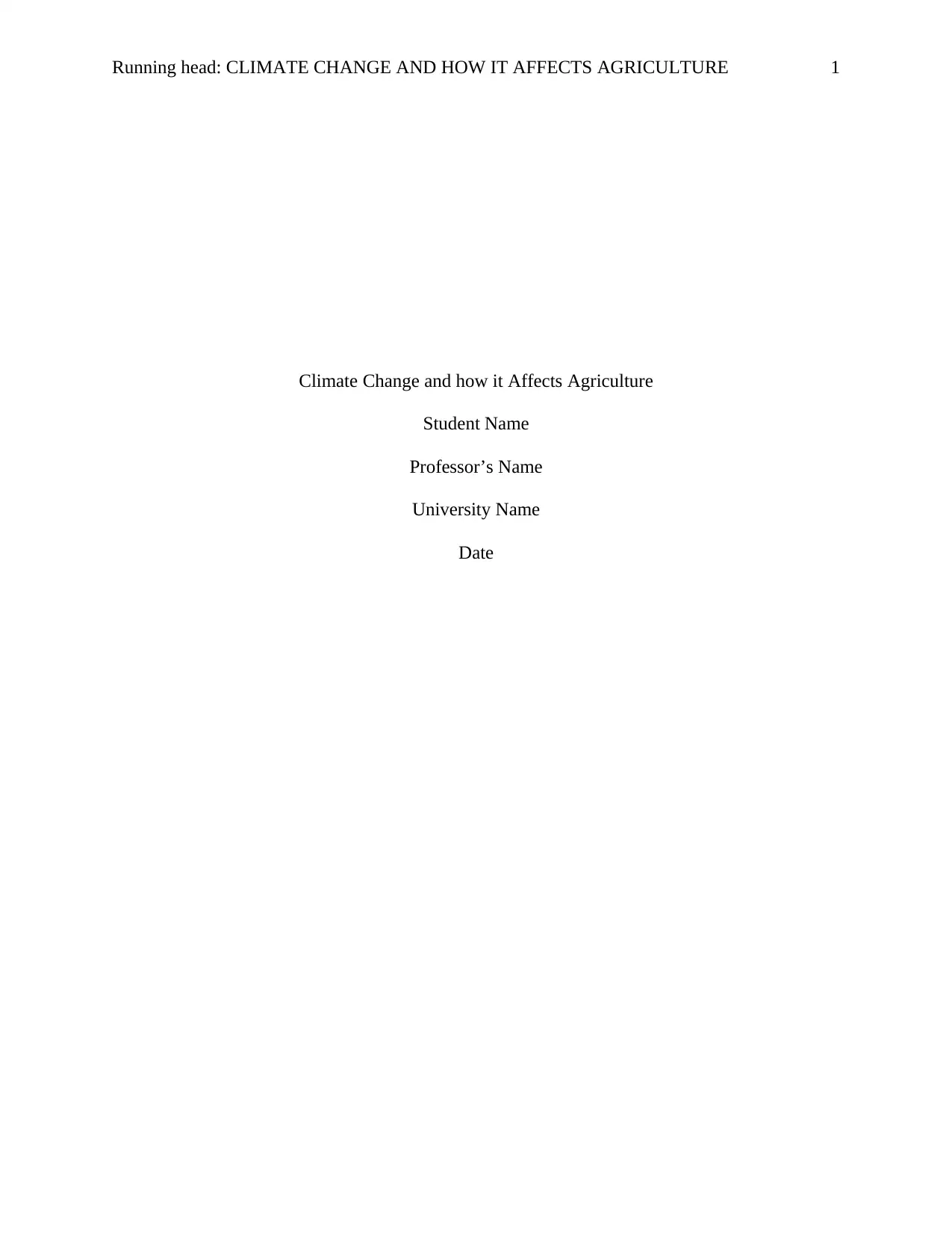
Running head: CLIMATE CHANGE AND HOW IT AFFECTS AGRICULTURE 1
Climate Change and how it Affects Agriculture
Student Name
Professor’s Name
University Name
Date
Climate Change and how it Affects Agriculture
Student Name
Professor’s Name
University Name
Date
Paraphrase This Document
Need a fresh take? Get an instant paraphrase of this document with our AI Paraphraser
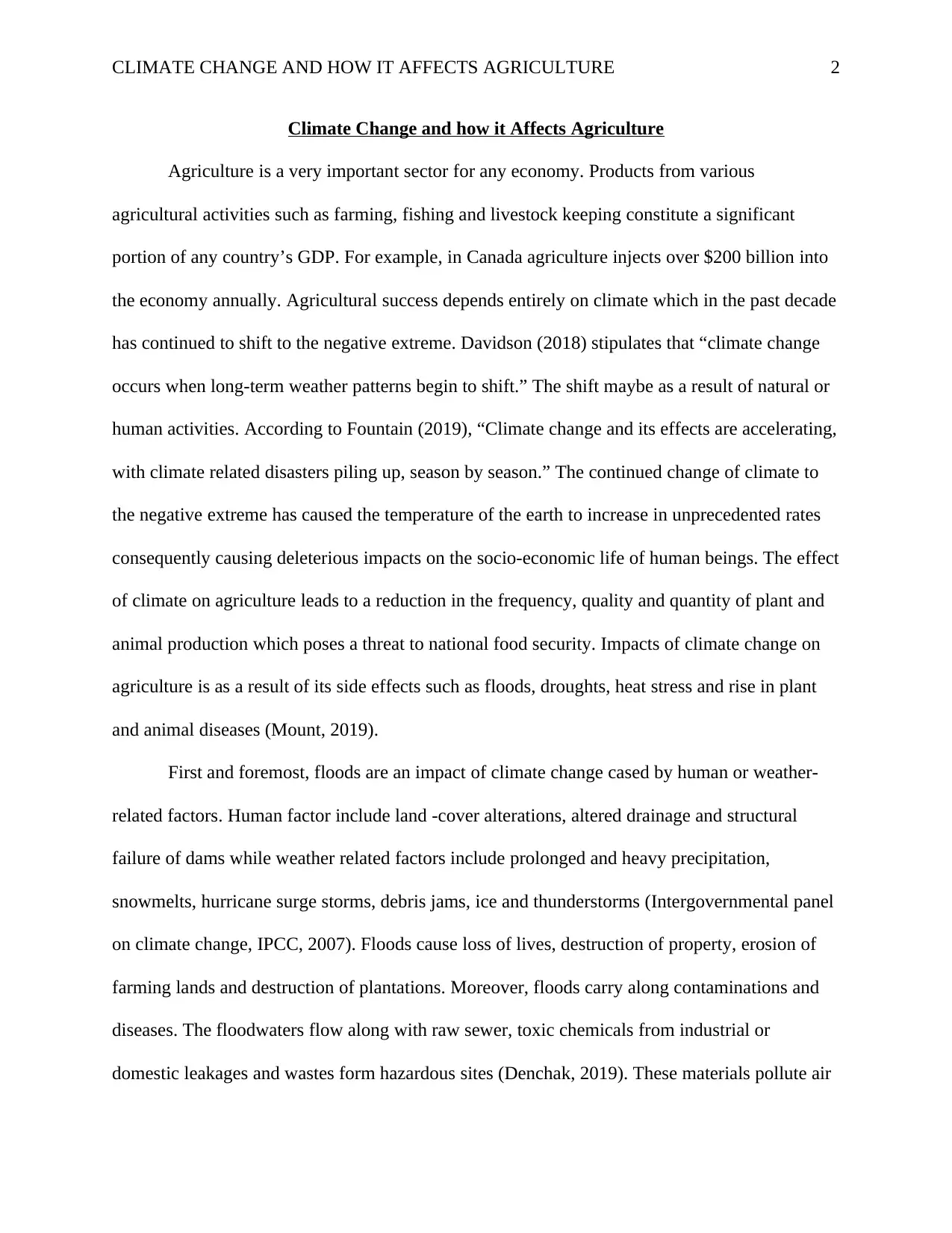
CLIMATE CHANGE AND HOW IT AFFECTS AGRICULTURE 2
Climate Change and how it Affects Agriculture
Agriculture is a very important sector for any economy. Products from various
agricultural activities such as farming, fishing and livestock keeping constitute a significant
portion of any country’s GDP. For example, in Canada agriculture injects over $200 billion into
the economy annually. Agricultural success depends entirely on climate which in the past decade
has continued to shift to the negative extreme. Davidson (2018) stipulates that “climate change
occurs when long-term weather patterns begin to shift.” The shift maybe as a result of natural or
human activities. According to Fountain (2019), “Climate change and its effects are accelerating,
with climate related disasters piling up, season by season.” The continued change of climate to
the negative extreme has caused the temperature of the earth to increase in unprecedented rates
consequently causing deleterious impacts on the socio-economic life of human beings. The effect
of climate on agriculture leads to a reduction in the frequency, quality and quantity of plant and
animal production which poses a threat to national food security. Impacts of climate change on
agriculture is as a result of its side effects such as floods, droughts, heat stress and rise in plant
and animal diseases (Mount, 2019).
First and foremost, floods are an impact of climate change cased by human or weather-
related factors. Human factor include land -cover alterations, altered drainage and structural
failure of dams while weather related factors include prolonged and heavy precipitation,
snowmelts, hurricane surge storms, debris jams, ice and thunderstorms (Intergovernmental panel
on climate change, IPCC, 2007). Floods cause loss of lives, destruction of property, erosion of
farming lands and destruction of plantations. Moreover, floods carry along contaminations and
diseases. The floodwaters flow along with raw sewer, toxic chemicals from industrial or
domestic leakages and wastes form hazardous sites (Denchak, 2019). These materials pollute air
Climate Change and how it Affects Agriculture
Agriculture is a very important sector for any economy. Products from various
agricultural activities such as farming, fishing and livestock keeping constitute a significant
portion of any country’s GDP. For example, in Canada agriculture injects over $200 billion into
the economy annually. Agricultural success depends entirely on climate which in the past decade
has continued to shift to the negative extreme. Davidson (2018) stipulates that “climate change
occurs when long-term weather patterns begin to shift.” The shift maybe as a result of natural or
human activities. According to Fountain (2019), “Climate change and its effects are accelerating,
with climate related disasters piling up, season by season.” The continued change of climate to
the negative extreme has caused the temperature of the earth to increase in unprecedented rates
consequently causing deleterious impacts on the socio-economic life of human beings. The effect
of climate on agriculture leads to a reduction in the frequency, quality and quantity of plant and
animal production which poses a threat to national food security. Impacts of climate change on
agriculture is as a result of its side effects such as floods, droughts, heat stress and rise in plant
and animal diseases (Mount, 2019).
First and foremost, floods are an impact of climate change cased by human or weather-
related factors. Human factor include land -cover alterations, altered drainage and structural
failure of dams while weather related factors include prolonged and heavy precipitation,
snowmelts, hurricane surge storms, debris jams, ice and thunderstorms (Intergovernmental panel
on climate change, IPCC, 2007). Floods cause loss of lives, destruction of property, erosion of
farming lands and destruction of plantations. Moreover, floods carry along contaminations and
diseases. The floodwaters flow along with raw sewer, toxic chemicals from industrial or
domestic leakages and wastes form hazardous sites (Denchak, 2019). These materials pollute air
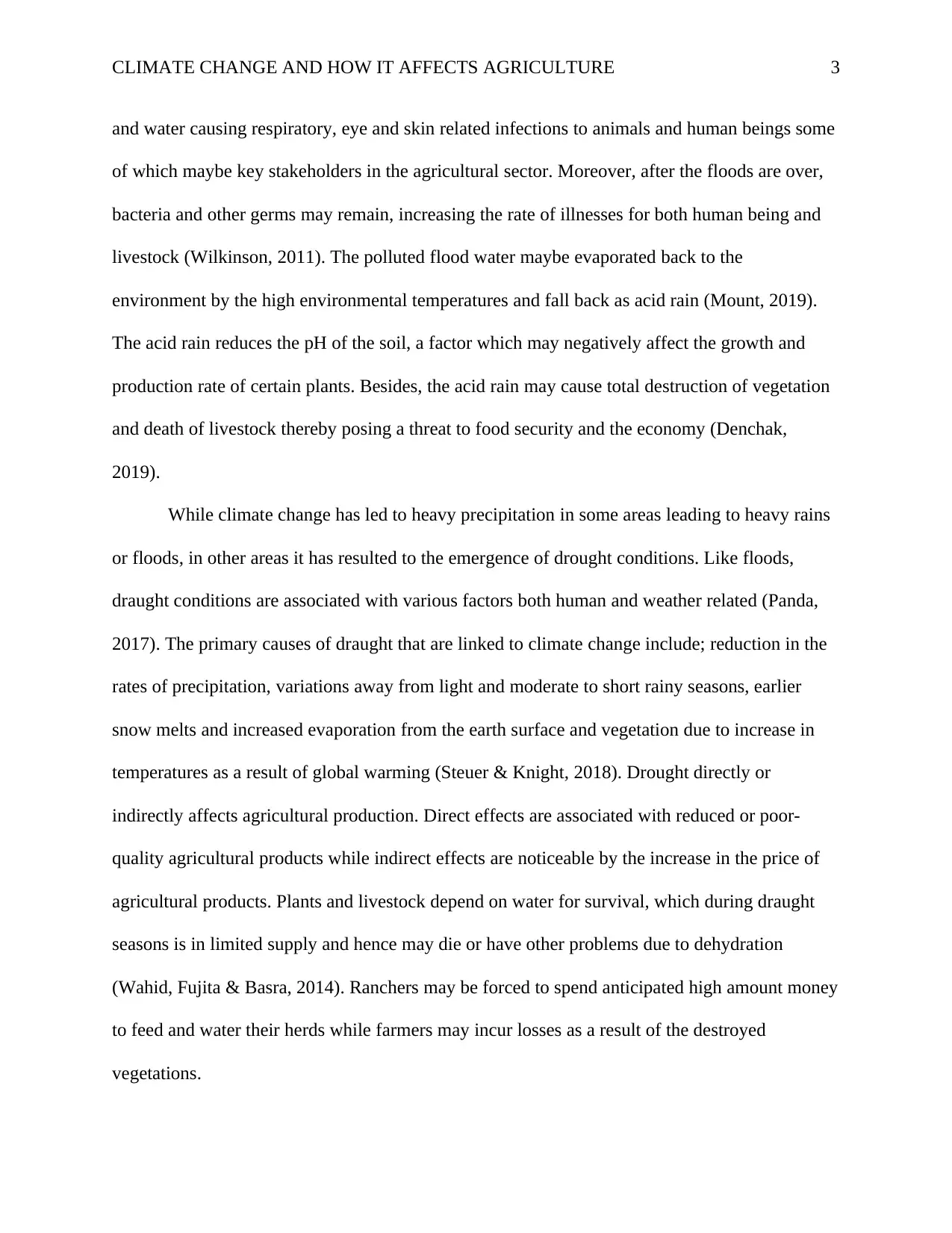
CLIMATE CHANGE AND HOW IT AFFECTS AGRICULTURE 3
and water causing respiratory, eye and skin related infections to animals and human beings some
of which maybe key stakeholders in the agricultural sector. Moreover, after the floods are over,
bacteria and other germs may remain, increasing the rate of illnesses for both human being and
livestock (Wilkinson, 2011). The polluted flood water maybe evaporated back to the
environment by the high environmental temperatures and fall back as acid rain (Mount, 2019).
The acid rain reduces the pH of the soil, a factor which may negatively affect the growth and
production rate of certain plants. Besides, the acid rain may cause total destruction of vegetation
and death of livestock thereby posing a threat to food security and the economy (Denchak,
2019).
While climate change has led to heavy precipitation in some areas leading to heavy rains
or floods, in other areas it has resulted to the emergence of drought conditions. Like floods,
draught conditions are associated with various factors both human and weather related (Panda,
2017). The primary causes of draught that are linked to climate change include; reduction in the
rates of precipitation, variations away from light and moderate to short rainy seasons, earlier
snow melts and increased evaporation from the earth surface and vegetation due to increase in
temperatures as a result of global warming (Steuer & Knight, 2018). Drought directly or
indirectly affects agricultural production. Direct effects are associated with reduced or poor-
quality agricultural products while indirect effects are noticeable by the increase in the price of
agricultural products. Plants and livestock depend on water for survival, which during draught
seasons is in limited supply and hence may die or have other problems due to dehydration
(Wahid, Fujita & Basra, 2014). Ranchers may be forced to spend anticipated high amount money
to feed and water their herds while farmers may incur losses as a result of the destroyed
vegetations.
and water causing respiratory, eye and skin related infections to animals and human beings some
of which maybe key stakeholders in the agricultural sector. Moreover, after the floods are over,
bacteria and other germs may remain, increasing the rate of illnesses for both human being and
livestock (Wilkinson, 2011). The polluted flood water maybe evaporated back to the
environment by the high environmental temperatures and fall back as acid rain (Mount, 2019).
The acid rain reduces the pH of the soil, a factor which may negatively affect the growth and
production rate of certain plants. Besides, the acid rain may cause total destruction of vegetation
and death of livestock thereby posing a threat to food security and the economy (Denchak,
2019).
While climate change has led to heavy precipitation in some areas leading to heavy rains
or floods, in other areas it has resulted to the emergence of drought conditions. Like floods,
draught conditions are associated with various factors both human and weather related (Panda,
2017). The primary causes of draught that are linked to climate change include; reduction in the
rates of precipitation, variations away from light and moderate to short rainy seasons, earlier
snow melts and increased evaporation from the earth surface and vegetation due to increase in
temperatures as a result of global warming (Steuer & Knight, 2018). Drought directly or
indirectly affects agricultural production. Direct effects are associated with reduced or poor-
quality agricultural products while indirect effects are noticeable by the increase in the price of
agricultural products. Plants and livestock depend on water for survival, which during draught
seasons is in limited supply and hence may die or have other problems due to dehydration
(Wahid, Fujita & Basra, 2014). Ranchers may be forced to spend anticipated high amount money
to feed and water their herds while farmers may incur losses as a result of the destroyed
vegetations.
⊘ This is a preview!⊘
Do you want full access?
Subscribe today to unlock all pages.

Trusted by 1+ million students worldwide
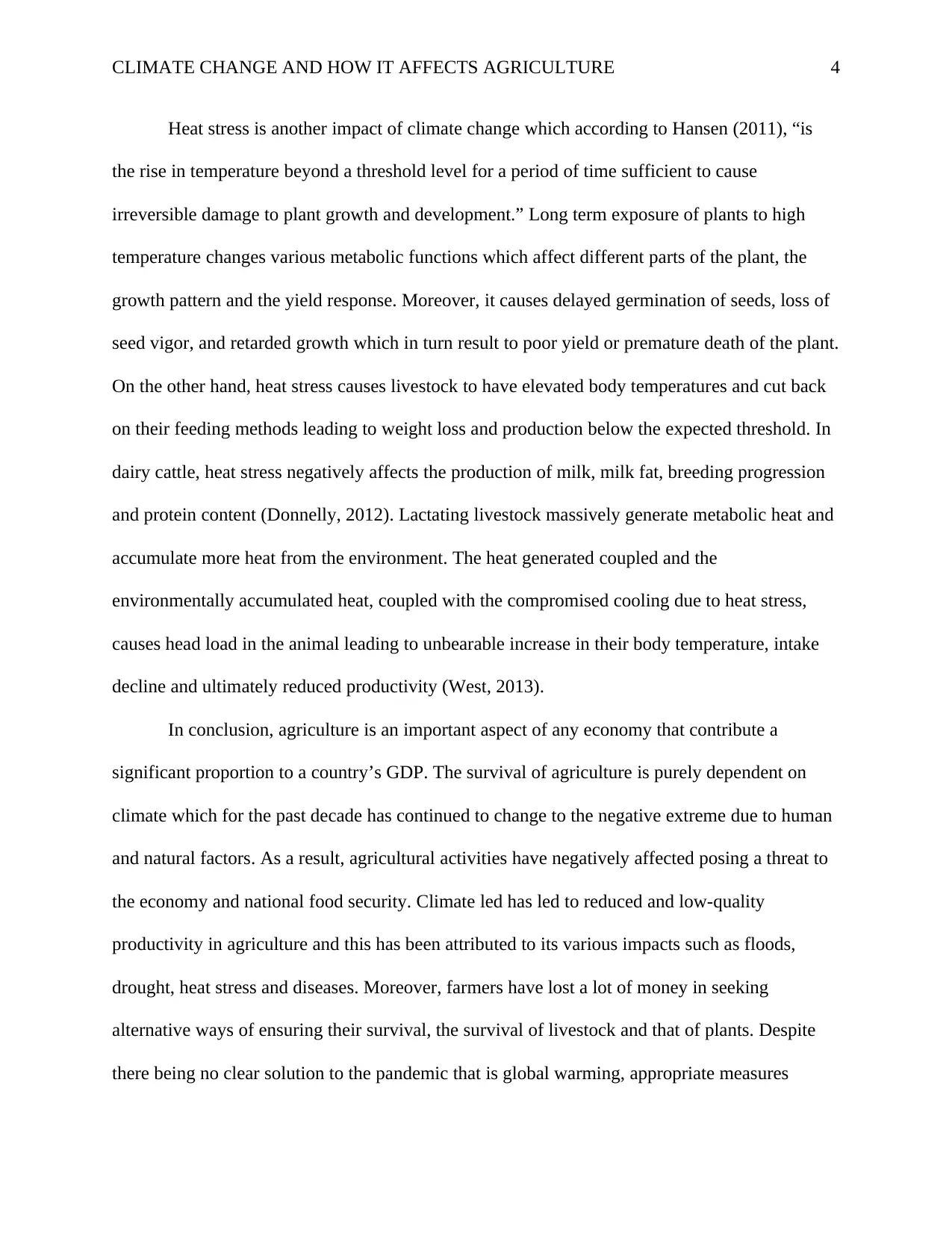
CLIMATE CHANGE AND HOW IT AFFECTS AGRICULTURE 4
Heat stress is another impact of climate change which according to Hansen (2011), “is
the rise in temperature beyond a threshold level for a period of time sufficient to cause
irreversible damage to plant growth and development.” Long term exposure of plants to high
temperature changes various metabolic functions which affect different parts of the plant, the
growth pattern and the yield response. Moreover, it causes delayed germination of seeds, loss of
seed vigor, and retarded growth which in turn result to poor yield or premature death of the plant.
On the other hand, heat stress causes livestock to have elevated body temperatures and cut back
on their feeding methods leading to weight loss and production below the expected threshold. In
dairy cattle, heat stress negatively affects the production of milk, milk fat, breeding progression
and protein content (Donnelly, 2012). Lactating livestock massively generate metabolic heat and
accumulate more heat from the environment. The heat generated coupled and the
environmentally accumulated heat, coupled with the compromised cooling due to heat stress,
causes head load in the animal leading to unbearable increase in their body temperature, intake
decline and ultimately reduced productivity (West, 2013).
In conclusion, agriculture is an important aspect of any economy that contribute a
significant proportion to a country’s GDP. The survival of agriculture is purely dependent on
climate which for the past decade has continued to change to the negative extreme due to human
and natural factors. As a result, agricultural activities have negatively affected posing a threat to
the economy and national food security. Climate led has led to reduced and low-quality
productivity in agriculture and this has been attributed to its various impacts such as floods,
drought, heat stress and diseases. Moreover, farmers have lost a lot of money in seeking
alternative ways of ensuring their survival, the survival of livestock and that of plants. Despite
there being no clear solution to the pandemic that is global warming, appropriate measures
Heat stress is another impact of climate change which according to Hansen (2011), “is
the rise in temperature beyond a threshold level for a period of time sufficient to cause
irreversible damage to plant growth and development.” Long term exposure of plants to high
temperature changes various metabolic functions which affect different parts of the plant, the
growth pattern and the yield response. Moreover, it causes delayed germination of seeds, loss of
seed vigor, and retarded growth which in turn result to poor yield or premature death of the plant.
On the other hand, heat stress causes livestock to have elevated body temperatures and cut back
on their feeding methods leading to weight loss and production below the expected threshold. In
dairy cattle, heat stress negatively affects the production of milk, milk fat, breeding progression
and protein content (Donnelly, 2012). Lactating livestock massively generate metabolic heat and
accumulate more heat from the environment. The heat generated coupled and the
environmentally accumulated heat, coupled with the compromised cooling due to heat stress,
causes head load in the animal leading to unbearable increase in their body temperature, intake
decline and ultimately reduced productivity (West, 2013).
In conclusion, agriculture is an important aspect of any economy that contribute a
significant proportion to a country’s GDP. The survival of agriculture is purely dependent on
climate which for the past decade has continued to change to the negative extreme due to human
and natural factors. As a result, agricultural activities have negatively affected posing a threat to
the economy and national food security. Climate led has led to reduced and low-quality
productivity in agriculture and this has been attributed to its various impacts such as floods,
drought, heat stress and diseases. Moreover, farmers have lost a lot of money in seeking
alternative ways of ensuring their survival, the survival of livestock and that of plants. Despite
there being no clear solution to the pandemic that is global warming, appropriate measures
Paraphrase This Document
Need a fresh take? Get an instant paraphrase of this document with our AI Paraphraser
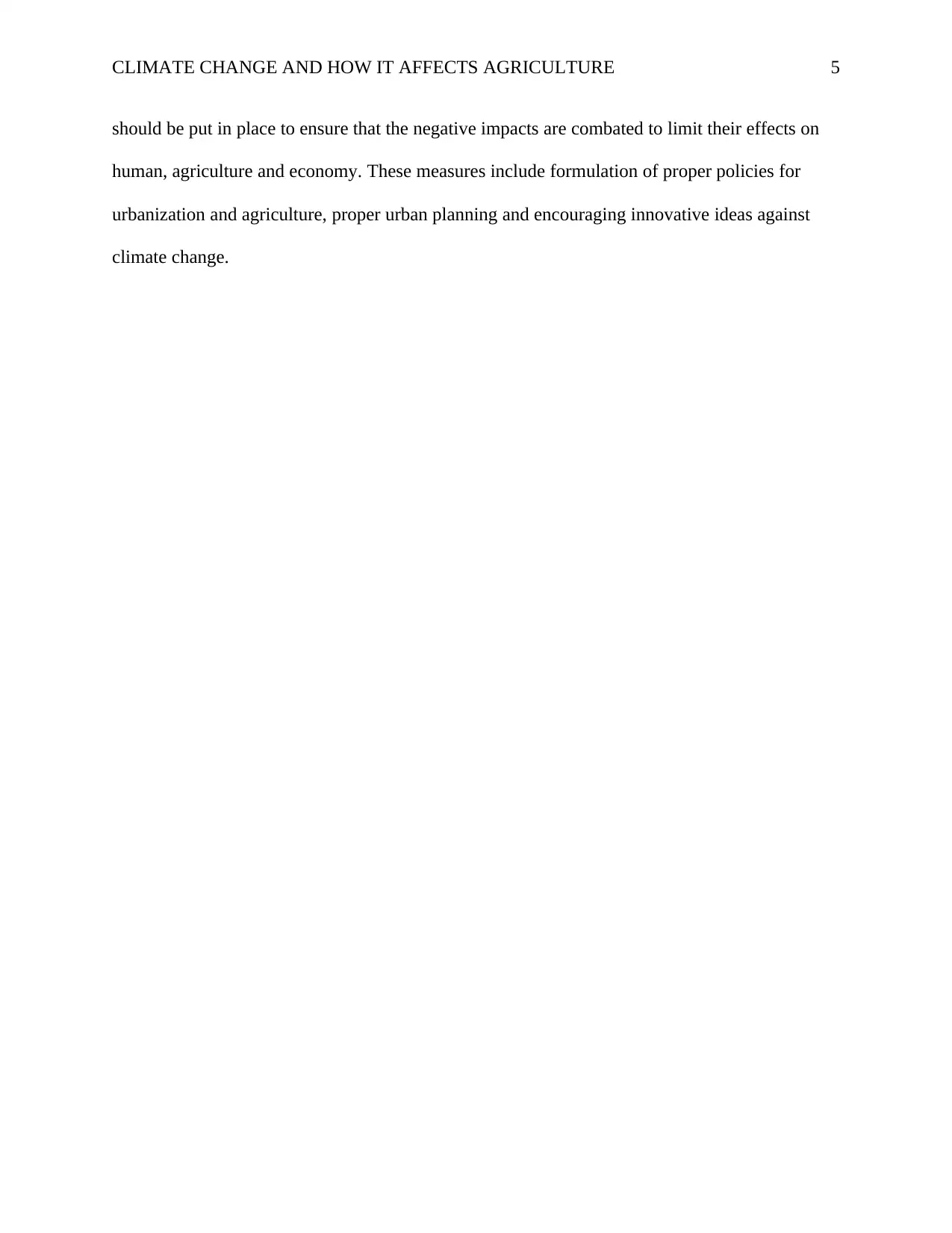
CLIMATE CHANGE AND HOW IT AFFECTS AGRICULTURE 5
should be put in place to ensure that the negative impacts are combated to limit their effects on
human, agriculture and economy. These measures include formulation of proper policies for
urbanization and agriculture, proper urban planning and encouraging innovative ideas against
climate change.
should be put in place to ensure that the negative impacts are combated to limit their effects on
human, agriculture and economy. These measures include formulation of proper policies for
urbanization and agriculture, proper urban planning and encouraging innovative ideas against
climate change.
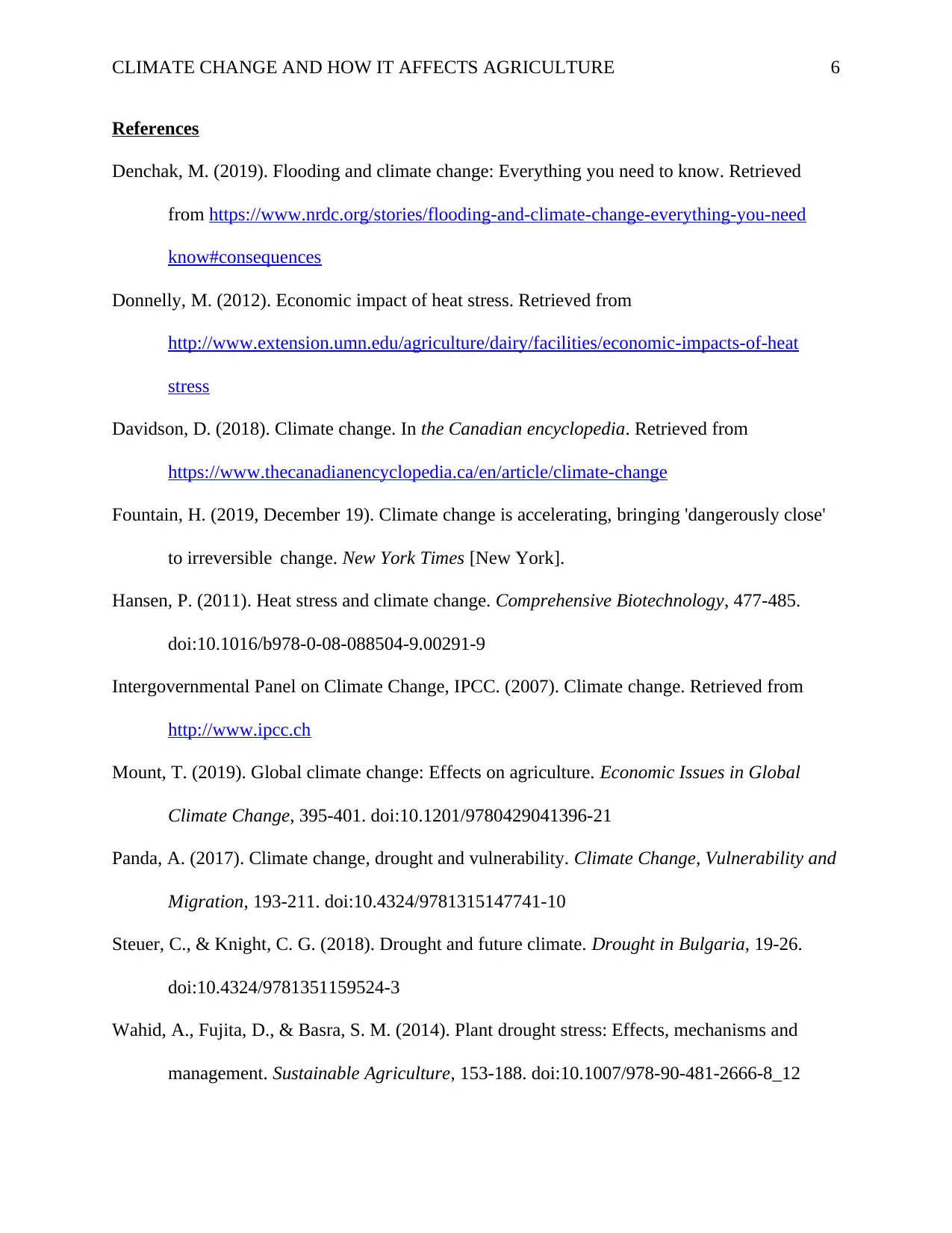
CLIMATE CHANGE AND HOW IT AFFECTS AGRICULTURE 6
References
Denchak, M. (2019). Flooding and climate change: Everything you need to know. Retrieved
from https://www.nrdc.org/stories/flooding-and-climate-change-everything-you-need
know#consequences
Donnelly, M. (2012). Economic impact of heat stress. Retrieved from
http://www.extension.umn.edu/agriculture/dairy/facilities/economic-impacts-of-heat
stress
Davidson, D. (2018). Climate change. In the Canadian encyclopedia. Retrieved from
https://www.thecanadianencyclopedia.ca/en/article/climate-change
Fountain, H. (2019, December 19). Climate change is accelerating, bringing 'dangerously close'
to irreversible change. New York Times [New York].
Hansen, P. (2011). Heat stress and climate change. Comprehensive Biotechnology, 477-485.
doi:10.1016/b978-0-08-088504-9.00291-9
Intergovernmental Panel on Climate Change, IPCC. (2007). Climate change. Retrieved from
http://www.ipcc.ch
Mount, T. (2019). Global climate change: Effects on agriculture. Economic Issues in Global
Climate Change, 395-401. doi:10.1201/9780429041396-21
Panda, A. (2017). Climate change, drought and vulnerability. Climate Change, Vulnerability and
Migration, 193-211. doi:10.4324/9781315147741-10
Steuer, C., & Knight, C. G. (2018). Drought and future climate. Drought in Bulgaria, 19-26.
doi:10.4324/9781351159524-3
Wahid, A., Fujita, D., & Basra, S. M. (2014). Plant drought stress: Effects, mechanisms and
management. Sustainable Agriculture, 153-188. doi:10.1007/978-90-481-2666-8_12
References
Denchak, M. (2019). Flooding and climate change: Everything you need to know. Retrieved
from https://www.nrdc.org/stories/flooding-and-climate-change-everything-you-need
know#consequences
Donnelly, M. (2012). Economic impact of heat stress. Retrieved from
http://www.extension.umn.edu/agriculture/dairy/facilities/economic-impacts-of-heat
stress
Davidson, D. (2018). Climate change. In the Canadian encyclopedia. Retrieved from
https://www.thecanadianencyclopedia.ca/en/article/climate-change
Fountain, H. (2019, December 19). Climate change is accelerating, bringing 'dangerously close'
to irreversible change. New York Times [New York].
Hansen, P. (2011). Heat stress and climate change. Comprehensive Biotechnology, 477-485.
doi:10.1016/b978-0-08-088504-9.00291-9
Intergovernmental Panel on Climate Change, IPCC. (2007). Climate change. Retrieved from
http://www.ipcc.ch
Mount, T. (2019). Global climate change: Effects on agriculture. Economic Issues in Global
Climate Change, 395-401. doi:10.1201/9780429041396-21
Panda, A. (2017). Climate change, drought and vulnerability. Climate Change, Vulnerability and
Migration, 193-211. doi:10.4324/9781315147741-10
Steuer, C., & Knight, C. G. (2018). Drought and future climate. Drought in Bulgaria, 19-26.
doi:10.4324/9781351159524-3
Wahid, A., Fujita, D., & Basra, S. M. (2014). Plant drought stress: Effects, mechanisms and
management. Sustainable Agriculture, 153-188. doi:10.1007/978-90-481-2666-8_12
⊘ This is a preview!⊘
Do you want full access?
Subscribe today to unlock all pages.

Trusted by 1+ million students worldwide
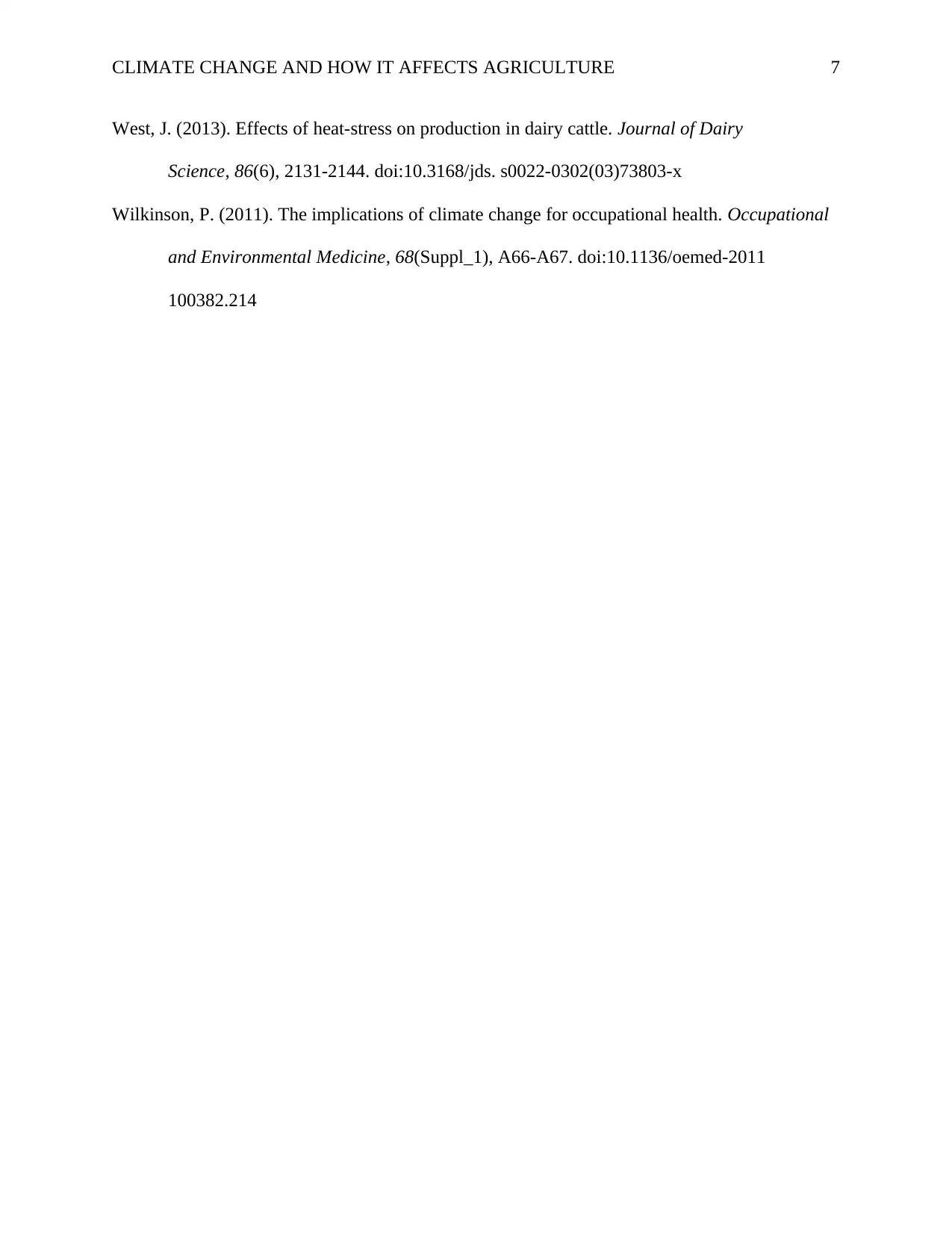
CLIMATE CHANGE AND HOW IT AFFECTS AGRICULTURE 7
West, J. (2013). Effects of heat-stress on production in dairy cattle. Journal of Dairy
Science, 86(6), 2131-2144. doi:10.3168/jds. s0022-0302(03)73803-x
Wilkinson, P. (2011). The implications of climate change for occupational health. Occupational
and Environmental Medicine, 68(Suppl_1), A66-A67. doi:10.1136/oemed-2011
100382.214
West, J. (2013). Effects of heat-stress on production in dairy cattle. Journal of Dairy
Science, 86(6), 2131-2144. doi:10.3168/jds. s0022-0302(03)73803-x
Wilkinson, P. (2011). The implications of climate change for occupational health. Occupational
and Environmental Medicine, 68(Suppl_1), A66-A67. doi:10.1136/oemed-2011
100382.214
1 out of 7
Related Documents
Your All-in-One AI-Powered Toolkit for Academic Success.
+13062052269
info@desklib.com
Available 24*7 on WhatsApp / Email
![[object Object]](/_next/static/media/star-bottom.7253800d.svg)
Unlock your academic potential
Copyright © 2020–2025 A2Z Services. All Rights Reserved. Developed and managed by ZUCOL.



